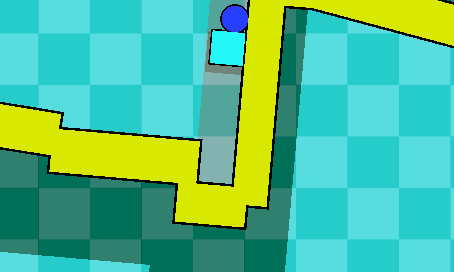In the time I have spent working with elementary school students this school year, the gamification they demand from their learning has been palpable. Every day, their teacher gives them time to work from a selection of approved websites, typically linked on the classroom’s Clever page, that offer interactive educational activities for practice. However, despite the fact that they have access to Imagine Math, SplashLearn, and Prodigy, all three being platforms that provide math practice in an acceptably effective medium, a few students have attached themselves to a far more questionable activity in the form of Tricky Ball.
A little lesson in trickery
Hosted by IXL Learning on multiplication.com, Tricky Ball is a platformer game that requires the player to move a ball to a goal through a single mode of input. The position and movement of every teal block on the stage depends on whether the mouse is held down, either directly pushing the ball further or allowing the physics engine to make that progress. At this point, you may be wondering what this has anything to do with multiplication practice. To partly answer that question, it originally did not. A quick Google search for the game reveals that the people behind IXL were not the original developers—an indie developer going by stefano1234 created it in 2019 using Construct 3. While you will see that IXL modified the game in a way that can rationalize porting it to their math website, I fundamentally disagree with the way they structured it.
IXL allows kids to practice multiplication (and addition) through Tricky Ball by requiring them to answer a set of problems before selecting what level they want to play. The gameplay itself is unchanged and void of any math, instead providing math practice as a gated intermission to the main spectacle. The resulting experience is both unpleasant and unproductive. Claiming that the multiplication in Tricky Ball meaningfully engages students is like claiming the advertisements in YouTube videos and free mobile games do the same for their consumers. People consume media specifically for that media. Being obstructed by media that has nothing to do with it, educational or not, undermines its purpose by framing it as an obligation, an inconvenience to something more important. I can only imagine the disappointment of a young student playing Tricky Ball for the first time and immediately being met with a screen asking them what 7×5 is.
A counterpoint to my claim may be that in a post-COVID information era dominated by short-form content, the multiplication breaks in Tricky Ball actually align with the short attention spans of students. While I have personally seen students continue to play it despite the game design issue I mentioned, that alone is not indicative of engagement. What does affect student engagement is the fact that Tricky Ball uses multiple-choice problems without affirming or providing any conceptual understanding after they answer. IXL pairs an engaging game with a comparatively bland exercise in memorization, a design choice that pushes students to the former and kills virtually all educational value. The students that do play Tricky Ball ultimately play with emphasis on the game—most brute-force their way through the problem sets for a chance to do something they actually enjoy.
To further illustrate how Tricky Ball detracts from students’ learning, I want to model the way students interact with the game in terms of time, its most definable cost. Making the generous assumption that it takes a full second for students to select one of the four multiple-choice options on a touchscreen device without thinking, it will take an average of 2.5 seconds to complete a problem. Whether it is worthwhile for a student to organically solve each problem depends on their ability to do so at an average faster than that. Although some students I work with are at that level, others need support that Tricky Ball simply does not provide. Even if students do reach the proficiency necessary to outpace the brute-force method, they may choose not to use it due to the associated uncertainty. As young children still learning multiplication, they do not know how long it would take them to solve each problem unless they actually do it. What they do know is how long it would take them to press a few numbered buttons—a trivial amount of time and mental effort for a guaranteed reward. These backwards incentives discourage sincere engagement with math on a metric that disproportionately includes the students who need more support.
Let’s try something else
(Yes, you can do this by zooming out on your browser.)
The original Tricky Ball may be a harmless game that would play well on children’s mobile devices, but IXL’s version is a complete bastardization—it attempts to juggle recreational and educational interests without making an effort to integrate the two. Gripes I have with the three platforms I mentioned in the introduction pale in comparison to the ones I have with this game. As flawed as they may be, their math at least exists without an immediate conflict of interest.
Part of me believes this formula came about as a half-measure for students insecure about playing video games in school, as if poorly interrupting someone else’s game with multiplication lends it meaningful educational value. At least in this case, I see no path to consolidation without remaking the entire game. Tricky Ball should play to its strengths as a non-educational game for students to play in their free time. Problem sets should play to their strengths as non-rigorous evaluations of student progress.
Curious to see if IXL had anything better to offer on multiplication.com, I visited the games page and found six games listed in the Editor’s Pick section—presumably the best they had to offer. The first five games followed virtually the same formula as Tricky Ball, gatekeeping gameplay with multiple-choice arithmetic problems that had no other bearing on it. The sixth game was Tricky Ball.






